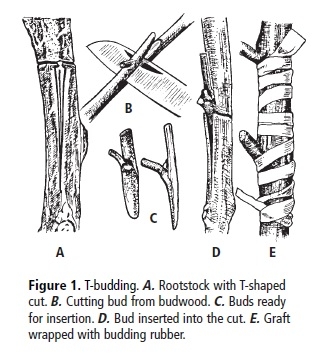Help and Advice from the Contra Costa Master Gardener Help Desk
Client's Request/Question:
I'd like to increase the varieties on my existing citrus trees. I understand that I can do that by either budding or grafting. Can you help me find some guidance on how to do budding and grafting?
CCMG Help Desk Response
Thank you for calling the Master Gardener help desk this morning.
I found an excellent and free UC publication about budding and grafting citrus (and avocado). "Budding and Grafting Citrus and Avocado in the Home Garden" Here is the link to it: http://homeorchard.ucdavis.edu/8001.pdf.

There are also several videos available from various agricultural universities (Texas and Florida). A list of some that are available can be found on YouTube (click). We strongly suggest that you give first priority to the agriculture or horticultural institutions web sites (*.edu).
Bay Area wise, I also found a Santa Clara Master Gardener article about his year-round citrus in San Jose at https://www.mastergardeners.org/picks/citrus.html that you might find interesting and give you some ideas on his success with particular varieties. California Rare Fruit Growers (crfg.org) could also be of interest, especially their scion exchange, usually in January.
IMPORTANT: I would also call to your attention that California is experiencing an invasion of a pest (Asian Citrus Psyllid) that carries the deadly bacteria “huanglongbing" (HLB), a devastating and fatal disease for citrus. There are currently citrus quarantine areas to the east and south of Contra Costa County. It is VERY important that you do not import citrus bud wood from any quarantine area and with caution from anywhere else (e.g. remainder of California, Florida, Texas, Arizona, etc.). More information and a map of the state quarantine areas can found here. One of the suspected causes of the early spread of HLB is backyard gardeners budding and/or grafting of citrus as well as some commercial nurseries moving infested nursery stock. Commercial California citrus nurseries have now taken very stringent steps to certify that their nursery stock is disease free.
Hope the above helps in your project. Please contact us again if you have more questions.
Good luck with your "new" citrus!
Contra Costa Master Gardeners Help Desk
Note: The Contra Costa Master Gardener Help Desk is available year-round to answer your gardening questions. Except for a few holidays, we're open every week, Monday through Thursday for walk-ins from 9:00 am to Noon at 75 Santa Barbara Road, 2d Floor, Pleasant Hill, CA 94523. We can also be reached via telephone: (925) 646-6586, email: ccmg@ucanr.edu, or on the web at http://ccmg.ucanr.edu/Ask_Us/